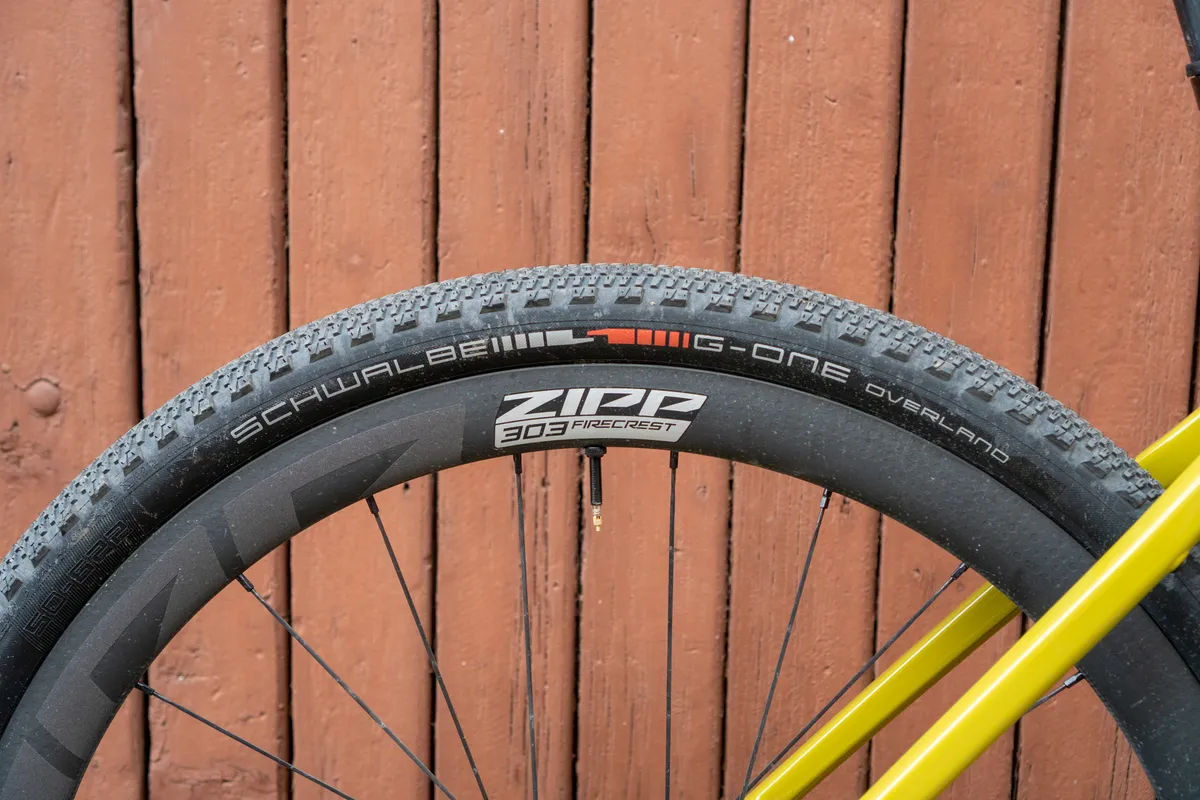Moots debuted a prototype gravel bike with larger-diameter 750d wheels at the 2023 edition of SBT GRVL.
750d gravel bike wheels – also known as 30in wheels – have an overall diameter (including tyres) similar to a 29in mountain bike wheel.
This prototype Routt CRDD (standing for ‘double D’ or ‘double dangerous’) was specced with 750d WTB KOM Light i25 rims wrapped in WTB Nano Raptor tyres – both also prototypes – in a 40mm width.
The prototype is a development of the brand’s recently launched Routt CRD.
Are we about to see the introduction of another new wheel-size standard? Let’s take a closer look at what 750d is, its claimed benefits, and whether we’re all going to be rolling on big gravel wheels in the near future.
What are 750d wheels and their purported benefits?

Like 650b and 700c wheels, the term ‘750d’ is derived from a French sizing system, with the number relating to the approximate diameter of the wheel with the tyre installed.
For example, a 650b/27.5in rim actually measures 584mm in diameter bead-to-bead, with a 700c rim coming in at 622mm.
750d rims are slightly larger, with a 660mm bead-to-bead diameter.
700c gravel bike tyres and 29in mountain bike tyres mount to rims of the same diameter. However, the overall size of a mountain bike wheel and tyre combination is larger due to the wider tyres.

James Heaton at WTB told BikeRadar: “Current 700c and 29in tyres mount to rims of the same diameter, but the overall diameter is noticeably larger on a 29in mountain bike tyre.
“The 750d tyre size increases the diameter of road and gravel tyres to a size more similar to that of a 29in [mountain bike] tyre.”
Moots says bigger-diameter wheels roll over rough terrain more easily thanks to their larger contact patch and increased momentum.
The brand also says they make a good option for custom bikes designed for taller riders.

Moots isn’t the first brand to experiment with 750d wheels – Zinn Cycles recommends the wheel size to riders 6ft 8in and upwards. Even larger 32in and 36in wheels have also been available for some years.
A larger wheel diameter for taller riders makes sense and the opposite is true for shorter cyclists.
For example, when Canyon manufactured women’s-specific road bikes, the two smallest sizes ran on smaller 650b wheels. The brand has now largely stepped away from gendered bikes, but continues to spec 650b wheels on its smallest frame sizes on its latest road bikes, such as the Endurace.
Smaller-sized frames fitted with 700c wheels typically require a slacker head angle to get them to fit, which can affect the handling of the bike. The smaller wheel size gets around this issue, so it only makes sense that larger bikes at the other end of the spectrum have larger wheels to maintain optimum handling characteristics.
What is the Moots Routt CRD?
The Moots Routt CRD is the brand’s latest titanium gravel race bike.
It is the first Moots gravel bike to sport a fully integrated front-end, following the brand’s first integrated road bike, the Vamoots CRD.
The current Routt CRD can accept up to 700c x 42mm tyres and uses a SRAM UDH to ensure compatibility with T-Type Eagle Transmission setups.
SBT GRVL, where the prototype Routt CRDD was on display, is a world-class 142-mile gravel race held in Steamboat Springs, Colorado, which is also the home of Moots.
How did we get here?

Unlike bottom bracket standards, debates about wheel size have remained serene in the road and, for the most part, gravel world.
700c has remained the norm on road and gravel bikes, although 650b is a popular option on some gravel bikes designed for more extreme riding. The smaller 650b wheel size allows for the use of a larger tyre without increasing the overall (combined) circumference of the wheel and tyre.
It’s a different story when it comes to mountain bike wheel sizes, with both 650b and 29in wheels usurping the once-ubiquitous 26in.
Although the market is skewed more towards 29er wheels, there remain plentiful options to cater for both sizes. Mullet bikes are popular, too, combining a 29in front wheel with a 27.5in/650b rear wheel. This combination is intended to improve the ability to hit big obstacles at the front of the bike, while keeping things manoeuvrable at the rear.
Analysis | Do we really need another wheel standard?
It’s easy to sigh at the thought of yet another new standard.
The fact Moots and WTB have manufactured working prototypes clearly suggests an interest in exploring wheel sizes.
However, there are a lot of hoops to jump through for the wheel size to become standardised.
When gravel bikes were in their infancy, they were largely specced with 700c wheels, before the adoption of 650b wheels came about for those who wanted to run larger-volume tyres.
Brands didn’t need to specifically widen frame clearances to accept the smaller wheels, whereas there will need to be a major shift in frame design if 750d is to become the norm.
This will require backing from not just bike manufacturers, but wheel and tyre brands too.
While the cycling industry is not afraid of introducing a new standard, we don’t think there’s a great danger of your 700c wheels becoming ‘obsolete’ overnight.
WTB’s Heaton told us the brand is “constantly prototyping to determine the next advancement in bike technology, but there is currently no production timeline for 750d. Our plans to move forward are dictated by brands' interests in this new wheel size”.
Even if we start to see brands jump on the 750d bandwagon, there isn’t anything wrong in having a choice.
Taller riders might enjoy the most significant benefit from the larger wheel size, allowing them to ride a bike with similar handling characteristics to smaller-sized bikes.
If that makes bikes better for more people, then that can only be a good thing.
And what about riders of a more average height, who might benefit from a wheel that rolls more easily over off-road terrain?
That’s a more difficult question because the shift required to port the current design thinking over to the larger wheel size is seismic compared to the theoretical benefit.
Riders haven’t lambasted 700c wheels for being unwieldy to handle over technical terrain, meaning there’s unlikely to be a genuine momentum behind converting to 750d.
Still, if manufacturers feel the improved performance – or opportunity to sell the next big thing – is worth the headache of yet another wheel-size evolution, it’ll be something they pursue. We’ll be watching with interest.
